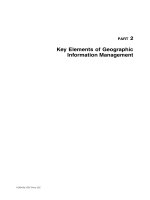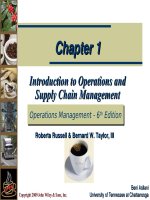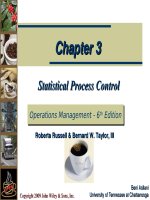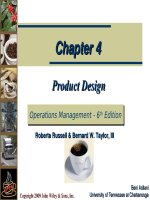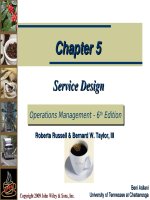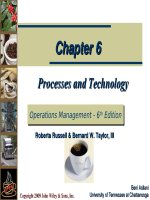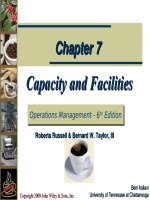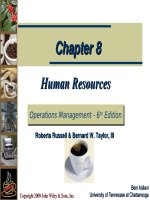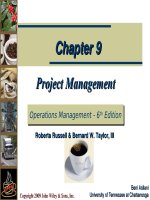Slide strategic management 6e by harrison chapter 3 the internal environment and strategic direction
Bạn đang xem bản rút gọn của tài liệu. Xem và tải ngay bản đầy đủ của tài liệu tại đây (119.83 KB, 15 trang )
Chapter 3
Organizational Resources and
Competitive Advantage
1
Learning Objectives
To understand:
• the characteristics of resources and capabilities that create a
foundation for sustainable competitive advantage
• how human resources, physical resources, financial resources,
knowledge and learning resources and general organizational
resources can lead to competitive advantage
• how resources are interconnected and the implications of
resource interconnectedness for competitive advantage
• the usefulness of the value chain in understanding sources of
competitive advantage
• traditional and stakeholder-based measures of firm performance
2
Strategic Management Process
External and Internal
Analysis
Strategic
Direction
Strategy Formulation
(corporate and
business level)
Strategy Implementation
and Control
Strategic Restructuring
3
Organizational Resources Leading to
Sustainable Competitive Advantage
Organizational
Resources and
Capabilities
Financial
Valuable?
Physical
Human
Knowledge &
Learning
Organizational
Unique?
Potential for
Competitive
Advantage
Appropriate
systems
in place?
Managers
taking
advantage
of potential?
Realized
Competitive
Advantage
Difficult or
costly to
imitate?
No readily
available
substitute?
Sustainable
Competitive
Advantage
4
Organizational Resource
Interconnectedness
Human Resources
Physical Resources
Financial Resources
Knowledge and
Learning Resources
General
Organizational
Resources
5
Human Resources
• Employees – recruitment, training programs,
rewards system
• Managers – CEO and top management team
• Owners/board of directors – effective
corporate governance
6
Physical Resources
• Tangible resources such as machinery, plants
and products – easy to imitate, but the
processes to create them are not
• Locations – competitive clusters can provide
advantages to companies and consumers
7
Financial Resources
• Strong cash flow, low levels of debt, strong
credit rating, access to low interest capital and
reputation for creditworthiness can increase
strategic flexibility – more responsive to new
opportunities
8
Use of Financial Analysis in
Strategic Management
• Identify strengths and weaknesses
• Diagnose problems
•
•
•
•
Declining profitability
Insufficient liquidity
Leverage too high or too low
Internal mismanagement
• Essential comparisons
• Firm to competitors
• Firm to itself over time
9
Some Commonly Used Ratios
•
Profitability
• Gross Profit Margin
• Net Profit Margin
• ROA
• ROE
• Liquidity
• Current
• Quick
• Leverage
• Debt to Equity
• Total Debt to Total Assets (Asset Ratio)
• Activity
• Asset Turnover
Average Collection Period
• Accounts Receivable Turnover
Inventory Turnover
10
Knowledge and Learning Resources
Organizational learning leads to strengths in other
resource areas. It involves:
•Knowledge creation
•Knowledge retention
•Knowledge sharing
•Knowledge utilization
Two types of knowledge:
•Codified – can be communicated with precision
through written means. Typically not a good source of
sustainable competitive advantage
•Tacit – difficult to describe with words. Better source of
sustainable competitive advantage
11
General Organizational Resources
Some general organizational resources are hard to
imitate and are therefore excellent sources of sustainable
competitive advantage:
•Organizational reputation
•Corporate brands
•Unique configurations of stakeholder relationships –
joint venture, long-term contracts and other types of
partnerships and alliances
•Organizational structure and internal systems
•Organizational culture
12
Value Chain Activities
Basic Value Chain Activities
Supply Chain
Internal
Distribution
Marketing
Management
Management
Operations
and Location
Management
of Post-
Management
Management
Transaction
Contacts
Activities that Support the Basic Value Chain Activities
Product/service R&D
Human resources/compensation systems
Financial management/accounting
Information technology (IT)
Legal support
Strategic planning processes
Consumer research
13
Firm Performance
• Traditionally performance measured as
financial performance (ROA, ROE,
shareholder returns)
Short-term mentality
Externalities
• Activities of the firm provide value to a broad
spectrum of stakeholders
Need a more balanced and complete set of measures
Reflect more of the value a firm creates for its stakeholders
14
Examples of Stakeholder-Based
Performance Measures
• Employees
Surveys of employee happiness
Turnover
• Customers
Growth in sales
Surveys of customer satisfaction
• Suppliers
Longevity of supplier relationships
Existence or absence of supplier-led legal actions
• Shareholders
Shareholder returns
Risk associated with returns
• Community
Inclusion on list of socially responsible firms
Percent of income donated to community or social causes
15
